nRF5 action!
-
BTW, I assembled my third board now, and it sleeps at about 9.9ua. The first one sleeps at about 6ua, and the second at about 9ua. It would be interesting to know why the first board is so much less, but it seems that about 9-10ua is the more typical number. That also seems to agree with @d00616 's measurements.
-
Interestingly enough, you can put the radio into receive mode and then sleep the mcu with the radio still in receive mode. Here's a screenshot of current consumption while receiving, where I alternate between leaving the mcu active or sleeping it (each for duration of 500ms). In-between, I sleep everything (both radio and mcu) for 1 second:
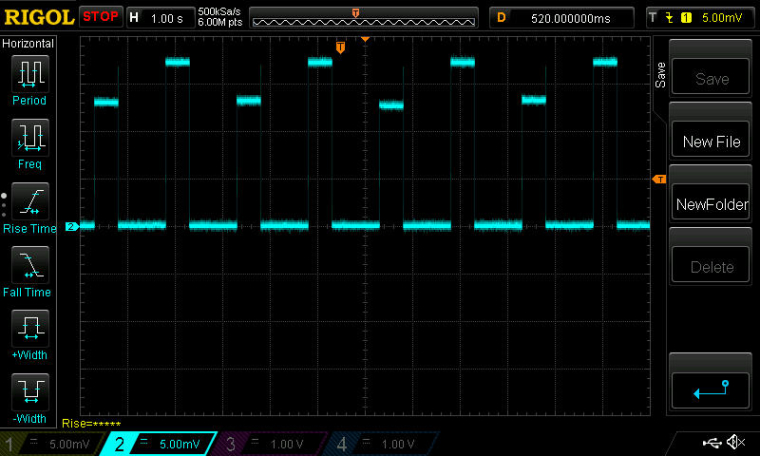
-
Here's the mode that I'm most interested in: Putting the radio into Rx for about 1ms per 100ms interval to listen for remote commands. The rest of the time everthing (both radio and mcu) are in deep sleep waiting for the RTC to wake them up.
Here's a close-up of the current drawn during that roughly 1ms interval:

I ran this just now, and my solar setup can easily handle this load during the daytime, even from deep indoors far from the windows. This was the scenario that really stressed the RFM69+atmega328p combo when I tried doing it using the RFM69's listen mode. I'll see tonight how the 10F supercap handles the load without any solar assist. :)
Because of the nRF52839's 2Mbps datarate, I can probably cut the listen window down substantially from 1ms to much less (much less than would be possible with an RFM69, due to its maximum of 300kbps datarate), but for ease of programming I'm starting with this.
-
Here's the mode that I'm most interested in: Putting the radio into Rx for about 1ms per 100ms interval to listen for remote commands. The rest of the time everthing (both radio and mcu) are in deep sleep waiting for the RTC to wake them up.
Here's a close-up of the current drawn during that roughly 1ms interval:

I ran this just now, and my solar setup can easily handle this load during the daytime, even from deep indoors far from the windows. This was the scenario that really stressed the RFM69+atmega328p combo when I tried doing it using the RFM69's listen mode. I'll see tonight how the 10F supercap handles the load without any solar assist. :)
Because of the nRF52839's 2Mbps datarate, I can probably cut the listen window down substantially from 1ms to much less (much less than would be possible with an RFM69, due to its maximum of 300kbps datarate), but for ease of programming I'm starting with this.
@NeverDie said in nRF5 Bluetooth action!:
Here's the mode that I'm most interested in: Putting the radio into Rx for about 1ms per 100ms interval to listen for remote commands. The rest of the time everthing (both radio and mcu) are in deep sleep waiting for the RTC to wake them up.
When you take a look into the PPI section, you are able to let the CPU sleep until a radio packet is received. With PPI, the listen mode can be activated and deactivated without CPU interaction.
The nRF5 MCUs are able to to a lot of things without waking up the CPU. That's a really cool feature.
-
@NeverDie said in nRF5 Bluetooth action!:
Here's the mode that I'm most interested in: Putting the radio into Rx for about 1ms per 100ms interval to listen for remote commands. The rest of the time everthing (both radio and mcu) are in deep sleep waiting for the RTC to wake them up.
When you take a look into the PPI section, you are able to let the CPU sleep until a radio packet is received. With PPI, the listen mode can be activated and deactivated without CPU interaction.
The nRF5 MCUs are able to to a lot of things without waking up the CPU. That's a really cool feature.
@d00616 said in nRF5 Bluetooth action!:
@NeverDie said in nRF5 Bluetooth action!:
Here's the mode that I'm most interested in: Putting the radio into Rx for about 1ms per 100ms interval to listen for remote commands. The rest of the time everthing (both radio and mcu) are in deep sleep waiting for the RTC to wake them up.
When you take a look into the PPI section, you are able to let the CPU sleep until a radio packet is received. With PPI, the listen mode can be activated and deactivated without CPU interaction.
The nRF5 MCUs are able to to a lot of things without waking up the CPU. That's a really cool feature.
Sounds like it has potential. Any demo code for this? The datasheet seems a bit sketchy.
-
@d00616 said in nRF5 Bluetooth action!:
@NeverDie said in nRF5 Bluetooth action!:
Here's the mode that I'm most interested in: Putting the radio into Rx for about 1ms per 100ms interval to listen for remote commands. The rest of the time everthing (both radio and mcu) are in deep sleep waiting for the RTC to wake them up.
When you take a look into the PPI section, you are able to let the CPU sleep until a radio packet is received. With PPI, the listen mode can be activated and deactivated without CPU interaction.
The nRF5 MCUs are able to to a lot of things without waking up the CPU. That's a really cool feature.
Sounds like it has potential. Any demo code for this? The datasheet seems a bit sketchy.
@NeverDie said in nRF5 Bluetooth action!:
@d00616 said in nRF5 Bluetooth action!:
@NeverDie said in nRF5 Bluetooth action!:
Here's the mode that I'm most interested in: Putting the radio into Rx for about 1ms per 100ms interval to listen for remote commands. The rest of the time everthing (both radio and mcu) are in deep sleep waiting for the RTC to wake them up.
When you take a look into the PPI section, you are able to let the CPU sleep until a radio packet is received. With PPI, the listen mode can be activated and deactivated without CPU interaction.
The nRF5 MCUs are able to to a lot of things without waking up the CPU. That's a really cool feature.Sounds like it has potential. Any demo code for this? The datasheet seems a bit sketchy.
These are some snippets of the radio code. There are fully useable PPI and some predefined. For fully useable PPI into the EEP register, you put the address of an EVENT register and in the TEP register, you put the pointer to an TASK register.
/** Configure PPI (Programmable peripheral interconnect) */ // Start timer on END event NRF_PPI->CH[NRF5_ESB_PPI_TIMER_START].EEP = (uint32_t)&NRF_RADIO->EVENTS_END; NRF_PPI->CH[NRF5_ESB_PPI_TIMER_START].TEP = (uint32_t)&NRF5_RADIO_TIMER->TASKS_START; // Disable Radio after CC[0] NRF_PPI->CH[NRF5_ESB_PPI_TIMER_RADIO_DISABLE].EEP = (uint32_t)&NRF5_RADIO_TIMER->EVENTS_COMPARE[0]; NRF_PPI->CH[NRF5_ESB_PPI_TIMER_RADIO_DISABLE].TEP = (uint32_t)&NRF_RADIO->TASKS_DISABLE; ... // Set PPI NRF_PPI->CHENSET = NRF5_ESB_PPI_BITS; ... // Clear PPI NRF_PPI->CHENCLR = NRF5_ESB_PPI_BITS;Then you have to enable or disable the register. It could be necessary to reset the events. You can use the NRF_RESET_EVENT macro to do this job.
NRF_RESET_EVENT(NRF5_RADIO_TIMER->EVENTS_COMPARE[0]); -
I have a brute force version of "listen mode" working using just the libraries, but I have to re-initialize the radio after each cycle because it appears to lose its settings every time I sleep it.
Anyway, finding a way to add DCDC mode to these modules will probably have the biggest near-term impact on current consumption. That said, I'm sure plenty of energy savings can also be found by honing the code.
-
I have a brute force version of "listen mode" working using just the libraries, but I have to re-initialize the radio after each cycle because it appears to lose its settings every time I sleep it.
Anyway, finding a way to add DCDC mode to these modules will probably have the biggest near-term impact on current consumption. That said, I'm sure plenty of energy savings can also be found by honing the code.
Actually, even just sleeping the MCU with a simple command like:
sleep(100);is apparently enough to require a re-init of the radio afterward. Not sure why that would be.
-
Comparing Figures 169 and 170 in the nRF52832 datasheet, it looks as though simply adding two inductors in series between DCC and DEC4 should be all that's needed to provide the needed hardware support for DC/DC. Looks as though the 10uH inductor also needs to be able to support a minimum of 50ma, according to the BOM (Table 145).
So, is it as simple as that together with enabling register DCDCEN? Or, is there anything more to it?
-
Yes. This is like that. I use 2 inductors (better) in serie. Why more complicated ;)
-
Actually, even just sleeping the MCU with a simple command like:
sleep(100);is apparently enough to require a re-init of the radio afterward. Not sure why that would be.
@NeverDie said in nRF5 Bluetooth action!:
Actually, even just sleeping the MCU with a simple command like:
sleep(100);is apparently enough to require a re-init of the radio afterward. Not sure why that would be.
sleep() deinitializes the transport with transportDisable(). This results in power down the radio.
At the moment I review the ESB code. I think the nRF5 is 12-13µs after an nRF24 in RX mode and 432µs before an nRF24 in TX. This can result in unstable connections when debug messages are disabled.
-
Sort-of working. Here's a screen shot with the DC/DC modification. Compare to the earlier one above:

Probably non-optimal placement of the inductors: between the DCC and DEC4 pins on my breakout board for the nRF52832.This is reason enough to do an new version of the breakout for the Ebyte module to improve the inductor positioning.
Here's the enable code:
NRF_POWER->DCDCEN=1; //enable the DCDC voltage regulator as the default.If it's this easy, I'm just surprised that the module makers haven't included it. The difference in build cost is de minimus, but the difference in delivered value is huge.
Also, it sounds like I'll have to write a variant of sleep that sleeps just the MPU while leaving the radio in receive mode. That's an easy win to improve the current consumption.
-
Good news! I went back and re-rechecked using an un-modified Ebyte module, and, indeed, this time I'm sure that the DCDC inductors are already on it! What follows is the proof. Here is the current drawn when the above DCDCEN is enabled on an unmodified Ebyte module: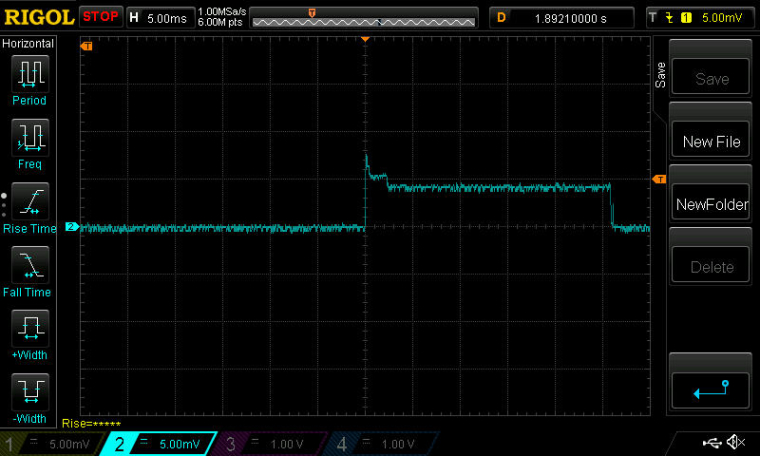
Now, here is the current drawn with the exact same script on the exact same unmodified Ebyte module, but with the DCDCEN line of code commented out:
QED.
As you can see, the savings in current consumption are considerable with the DCDC enabled![Edit: although looking at it again, the timescale seems way off. Argh. Something still isn't right.] -
Scratch the preceeding post. I redid it more carefully this time, and I believe it confirms that the Ebyte module does not have the two inductors required for DC/DC mode.
Here is the current drawn by an unmodified Ebyte nRF52832 module which is programmed to be receiving for about 1.5ms every 100ms:
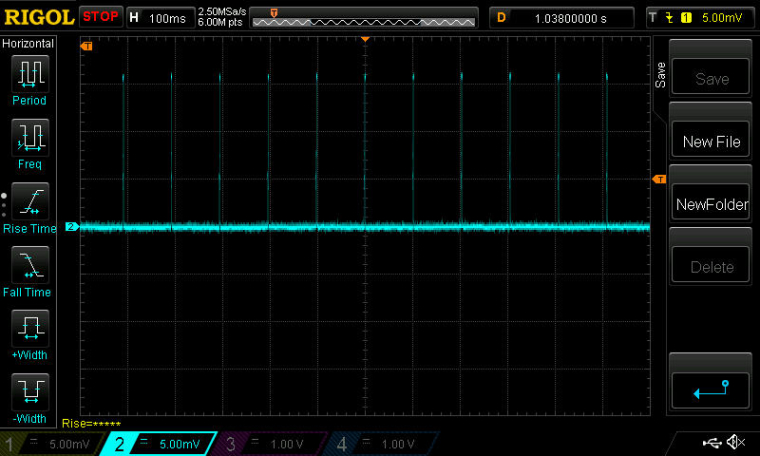

-
Here is what happens with exactly the same hardware (no inductors yet added), but with DCDCEN enabled:
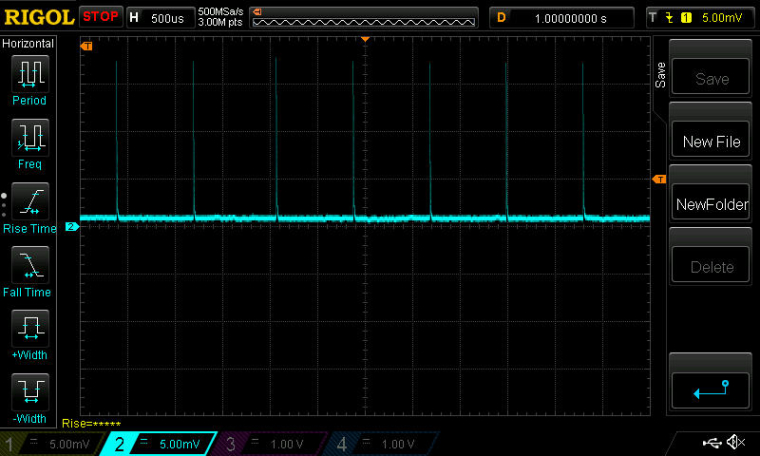

It basically seems caught in a boot loop. -
Now, adding the two inductors between DCC and DEC4, and re-measuring, we get:
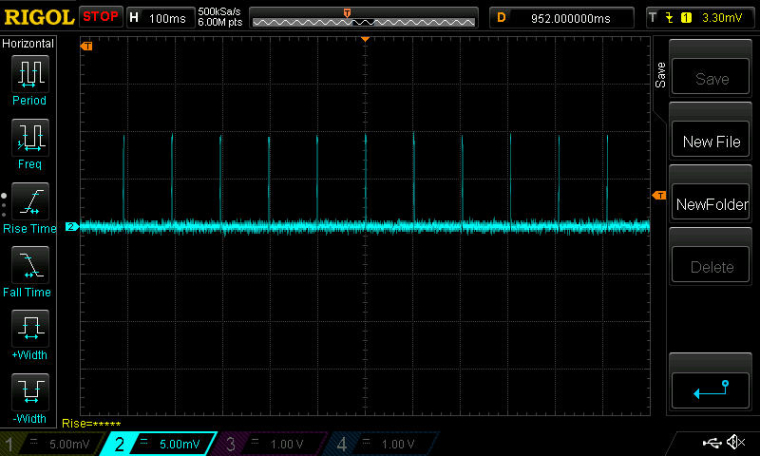
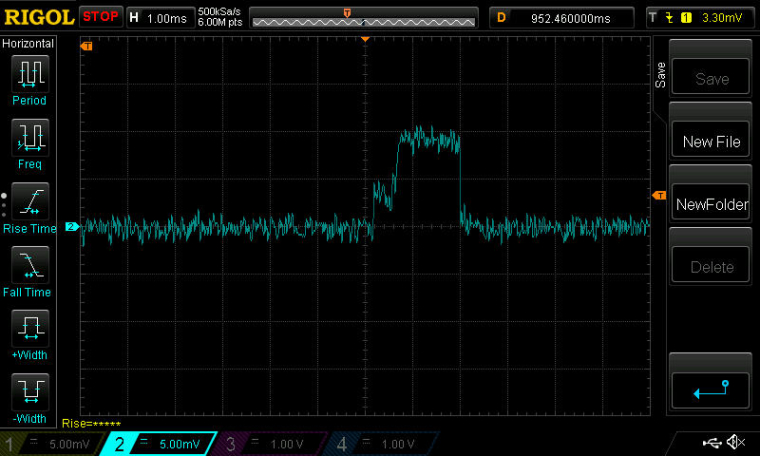
No less importantly, it does receive and decode packets!
Conclusion: Ebyte nRF52832 modules don't come with the DC/DC inductors already installed. However, they can be added, resulting in some current reduction.
-
I've baked these findings into a new breakout board for the Ebyte nRF52832:
https://www.openhardware.io/view/471
The new breakout board will enable the module to work in DC/DC mode. -
I may have found a clue as to why the reset pin (pin0.21) on the nRF52832 isn't working.
On the nRF52832 DK, I read the following register values:
PSELRESET[0]=21
PSELRESET[1]=21which is as expected. However, on the Ebyte nRF52832 module, I read those register values as:
PSELRESET[0]=4294967295
PSELRESET[1]=4294967295which makes no sense. The values match, but they don't correspond to a pin number that can represent RESET.
These two registers are described in the nRF52832 datasheet.
-
I may have found a clue as to why the reset pin (pin0.21) on the nRF52832 isn't working.
On the nRF52832 DK, I read the following register values:
PSELRESET[0]=21
PSELRESET[1]=21which is as expected. However, on the Ebyte nRF52832 module, I read those register values as:
PSELRESET[0]=4294967295
PSELRESET[1]=4294967295which makes no sense. The values match, but they don't correspond to a pin number that can represent RESET.
These two registers are described in the nRF52832 datasheet.
-
@NeverDie not sure if you've already noticed, but 4294967295 is the maximum value for an unsigned 32-bit integer. So the value is 0xFFFFFFFF. That often means uninitialized. I don't know why it would be uninitialized though.
Maybe because they just never were?
Those particular registers are "The user information configuration registers (UICRs) are non-volatile memory (NVM) registers for configuring user specific settings." So, it would seem that initializing them just once would be enough, since they're non-volatile.In any case, good catch! It explains both why they are that value and also why they match.
